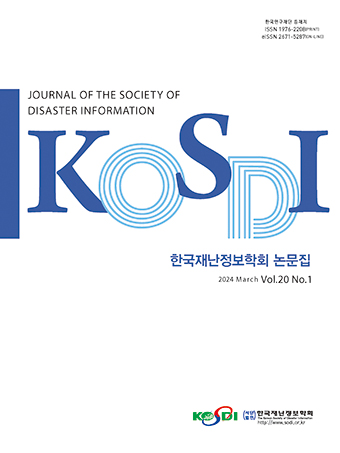Original Article
Abstract
References
Information
Purpose: The aim of this study is to analyze the trend for the dispatch of the 119 rescue teams to remove the beehive according to the distribution of temperature and time in Busan metropolitan city for 5 years from 2015. Method: From January 2015 to December 2019, 11 fire stations in Busan were dispatched and the source data of rescue and emergency activities were collected. The number of beehive removal dispatches was determined by the Busan Metropolitan Fire Station's jurisdiction over the past five years, and the temperature meteorological factors and honeycomb removal dispatches were analyzed in frequency and percentage. Result: The frequency of dispatch began to increase at an monthly average temperature of more than 20℃ and was higher at 23℃ to 29℃ than other temperature range. The highest frequency of dispatch was 7,900 cases in 2017. In particular, we found that the start timing of the honeycomb removal is getting faster as the year goes by. Gijang-gun had the largest frequency of dispatch, and Haeundae-gu, Geumjeong-gu, and Nam-gu were found to have a higher that. Conclusion: We found that the start timing of the honeycomb removal is getting faster as the year goes by and temperature changes. The results of this study are considered to be useful in future studies of wasps in urban areas.
연구목적: 본 연구는 2015년부터 5년 동안 부산광역시의 기온과 시기에 따른 119구조대의 벌집 제거 출동 경향을 분석하고자 하였다. 연구방법: 2015년 1월부터 2019년 12월까지 부산의 11개 소방서 출동 건수를 확인하고 구조 및 구급 활동의 원자료를 수집하였다. 5년간 부산광역시소방재난본부 산하 소방서의 벌집 제거 출동 건수를 파악하고, 그 결과를 바탕으로 온도와 월별, 행정구역별 벌집 제거 출동을 빈도와 백분율로 분석하였다. 연구결과: 월 평균기온이 20℃ 이상부터 출동 빈도가 증가하기 시작하여, 23℃ 이상 29℃ 미만에서 출동 빈도가 가장 높은 것으로 나타났고 월별 출동 건수 중 2017년 7,900건이 가장 높은 것으로 관찰되었다. 특히 벌집 제거 출동 시기가 해가 지날수록 빨라지는 것을 알 수 있었다. 부산광역시 행정구역별로 출동 건수를 비교한 결과, 기장군이 가장 많았으며, 해운대구, 금정구, 남구
순으로 출동 빈도가 높은 것으로 나타났다. 결론: 기온 변화에 따른 벌집 제거 출동이 점차 빨라지고 있는 것을 확인할 수 있었고, 본 연구의 결과가 차후 도시 내 말벌 연구에 활용될 수 있을 것으로 여겨진다.
- Bates, A.J., Sadler, J.P., Fairbrass, A.J., Falk, S.J., Hale, J.D., Matthews, T.J. (2011). "Changing bee and hoverfly pollinator assemblages along an urban-rural gradient." PLoS ONE, Vol. 6, No. 8, e23459. 10.1371/journal.pone.0023459 PMC3155562
- Carpenter, J.M. (1982). "The phylogenetic relationships and natural classification of the vespoidea(hymenoptera)." Systematic Entomology, Vol. 7, No. 1, pp. 11-38. 10.1111/j.1365-3113.1982.tb00124.x
- Choi, M.B., Kim, J.K., Lee. J.W. (2013). "A study on the organization and distribution of stock records with Korean wasps." Journal of the Korean Association of Applied Insects, Vol. 52, No. 2, pp. 85-91. 10.5656/KSAE.2013.02.1.072
- Choi, M.B., Kim, J.K., Lee, J.W. (2012). "Increase trend of social hymenoptera(wasps and honey bees) in urban area, inferred from moving-out case by 119 rescure servicesin Seoul of South Korea." Journal of the Korean Association of Insects, Vol. 42, No. 6, pp. 308-319. 10.1111/j.1748-5967.2012.00472.x
- Jung, C.L., Kang, M.S., Kim, D.W. (2007). "(Vespid wasps ptera) Occurring around apiaries in Andong, Korea: II. trap catches and seasonal dynamics." Journal of Apiculture, Vol. 22, No. 1, pp. 63-70.
- Jung, C.L. (2012)."Initial stage risk assessment of an invasive hornet, Vespa velutina nigrithorax buysson(hymenoptera: vespidae) in Korea." Journal of Apiculture, Vol. 27, No. 2, pp. 95-104.
- Gibbs, J.P., Stanton, E.J. (2001). "Habitat fragmentation and arthropod community change: Carrion beetles, phoretic mites, and flies." Ecological Application, Vol. 11, No. 1, pp. 79-85. 10.1890/1051-0761(2001)011[0079:HFAACC]2.0.CO;2
- Kim, H.M. (2018). Analysis of the Microenvironment Considering the Appearance of Wasps in the City. Masters Thesis, Dankook University.
- Korea Meteorological Administration (2020). Korean Climate Change Assessment Report 2020. Korea Meteorological Administration, Sejong, Korea.
- Nakamura, M. (2007). Vespa: Urban Invasion and Survival Strategy. Yasakashobo, Tokyo, Japan.
- National Fire Agency (2018). National Fire Agency statistical Year Book 2018. National Fire Agency, Sejong, Korea.
- National Fire Agency (2021). National Fire Agency statistical Year Book 2021. National Fire Agency, Sejong, Korea.
- Rural Development Administration (2020). A Study on the Current State and Application of Indicator Species of Climate Change on Agroecosystem. Rural Development Administration, Jeonju, Korea.
- Publisher :The Korean Society of Disaster Information
- Publisher(Ko) :한국재난정보학회
- Journal Title :Journal of the Society of Disaster Information
- Journal Title(Ko) :한국재난정보학회논문집
- Volume : 17
- No :4
- Pages :667-673
- DOI :https://doi.org/10.15683/kosdi.2021.12.31.667




 Journal of the Society of Disaster Information
Journal of the Society of Disaster Information







